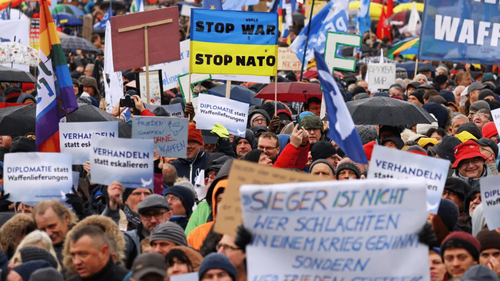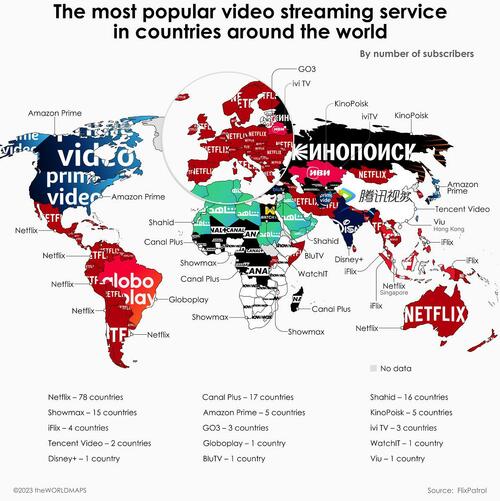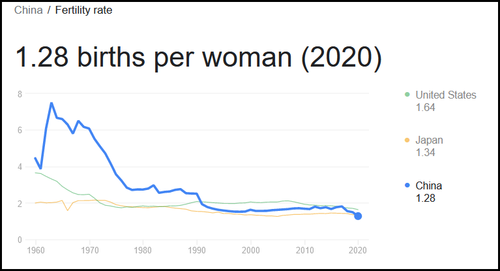European Antiwar Protests Grow As Fears Of NATO vs Russia Spiral
Via The Libertarian Institute,
A series of antiwar protests over the weekend saw Western European citizens in mass demanding their governments pursue diplomacy with Russia and halt arms shipments to Kiev. As the current conflict in Ukraine turned one year old, major demonstrations – which saw people united across the political spectrum – were seen in Germany, France, and Italy.
10,000 people gathered in Paris to protest against France’s membership in both NATO as well as the EU. Attendees also demanded an end to the French government’s military aid to Kiev. The demonstration, dubbed the “National March for Peace” was organized by the right-wing Les Patriotes party. According to the group’s leader Florian Philippot – who joined the Paris rally himself – similar but smaller protests were held at 30 other locations throughout the country on Sunday.
On Saturday, thousands of people participated in peace demonstrations in the Italian cities of Genoa and Milan. In Genoa, the rally focused on ending weapons shipments to Ukraine and was organized by union members and left-wing activists, whose slogan was “Lower weapons, raise wages.” 4,000 people from across Italy joined the Genoa protest, along with people from France and Switzerland as well, according to local media reports.
The Collective Autonomous Port Workers (CALP) helped organize the rally with the Italian communist party. They demanded the port of Genoa’s facilities no longer be used to facilitate arms shipments to Ukraine.
CALP’s Riccardo Rudino pointed out that “the conflict in Ukraine did not begin last year” but rather “in 2014, with the massacre of the Russian-speaking population of the Donbass.”
Following the U.S. backed 2014 coup in Kiev – which overthrew the government of former Ukrainian President Viktor Yanukovych – Russia annexed the Crimean peninsula, while over 14,000 people were killed, including thousands of civilians, in Kiev’s war on the breakaway republics of Donetsk and Luhansk.
In London, a large group carried out a similar demonstration calling for peace in Ukraine and an end to the British government’s weapons transfers to Kiev. The event was held by Stop the War Coalition at Portland Place in Central London and was attended by former Labour Party leader Jeremy Corbyn.
Many thousands of people participated in a massive protest in central Berlin, where attendees railed against German military aid to Kiev. The protesters, who were massed at the Brandenburg Gate, demanded additionally that their government engage Russia in peace talks and bring the war in Ukraine to an end.
The organizers say as many as 50,000 people joined the “Uprising for Peace” demonstrations. However, the police offered a lower-end estimate of 13,000 people in attendance. The event was organized by Sahra Wagenknecht, a member of the Links Party (the Left Party) in Germany, as well as a feminist author and campaigner Alice Schwarzer.
Wagenknecht declared neo-Nazis were not welcome at the protest, but anyone else who desired peace “with an honest heart” was welcome to attend. During her speech at the event, Wagenknecht declared the creation of a “new, strong peace movement in Germany.”
Nouvelle manifestation contre la subvention de la guerre en Ukraine 🇺🇦 et la sortie de la France 🇫🇷de l’OTAN.
Les médias continuent de nous ignorer, mais la résistance monte en France👊👉Des milliers de personnes à Paris ce 26/02/23 @_LesPatriotes @f_philippot ! #1an pic.twitter.com/3XKhijHoRc
— Tamila Tapayeva (@tamilatapayeva) February 26, 2023
She also observed that the myriad protestors were united by the fact that they do not feel represented by the government of Chancellor Olaf Scholz and his foreign minister, Annalena Baerbock, in their decision to supply Kiev with weaponry, including main battle tanks.In a reference to the drastic escalation of Berlin’s involvement in the war since last year, some banners read “Helmets today, tanks tomorrow, the day after tomorrow your sons.”
Other banners carried by the protesters bore such anti war slogans as “Stop the Killing,” “Not My War, Not My Government,” and “Diplomats instead of grenades.”
Two weeks prior to the protest, Wagenknecht and Schwarzer published a “Manifest for Peace” which demanded that Scholz “stop the escalation in weapons deliveries.” The petition has reportedly garnered more than 650,000 signatures, including some prominent intellectuals and political figures.
This weekend’s massive protests in Berlin followed a smaller demonstration at the end of January in Nuremberg, where participants rallied against Scholz’s decision to provide Leopard 2 battle tanks to Kiev. This month, around 10,000 people also protested in Munich during the Munich Security Conference, where Western leaders discussed funding, arming and training Ukrainian forces “as long as it takes” to defeat Russia.
Also on Sunday, in southwestern Germany, protesters gathered at the Ramstein air base – where the Ukraine Defense Contact Group’s meetings on arming Kiev are held – calling for an end to the weapons deliveries while demanding the U.S. Air Force to “go home.”
In Nuremberg, protestors expressed their dire concerns that the German people were being dragged into another war with Russia. As one demonstrator commented “If we Germans get involved in a war, and I personally do not have a war with Russia, then for us Germans, based on history, it is the worst sign that we can send.” The demonstrator continued, “no war must go through Germany, neither with arms deliveries nor anything else, because otherwise, Germany will be in the middle of it again.” He believes this is just what “America wants.”
Italy with protests too. Specifically anti-NATO involving thousands. All over where the Ukraine war is heading because these people believe there will be another World War raging across Europe if Russia is backed into a corner. pic.twitter.com/g65tblc7Ft
— GraphicW (@GraphicW5) February 26, 2023
The latest protests in Germany took place against the backdrop of veteran investigative journalist Seymour Hersh’s bombshell report “How America Took Out The Nord Stream Pipeline.”
Before the war began, Russia provided roughly a third of Europe’s gas, while Germany depended on Moscow for more than half of its gas supplies. After the Nord Stream pipelines were sabotaged, Russian President Vladimir Putin offered to ship gas to Europe via an undamaged line in Nord Stream 2. This offer was quickly rejected by Berlin.
Secretary of State Antony Blinken celebrated the blasts in the Baltic Sea – which, according to Hersh, were caused by explosives planted by U.S. Navy divers and detonated with a sonar buoy dropped by a Norwegian spy plane. Blinken described the attack as a “tremendous strategic opportunity” to wean Europe off its dependency on cheap Russian energy “for the years to come.” Since the attack, which led to possibly the largest ever leak of methane gas, the U.S. and Norway have taken Russia’s place as Europe’s top natural gas suppliers.
Activists picket near the Ramstein airbase in Germany, headquarters for the United States Air Forces in Europe – Air Forces Africa and also for NATO Allied Air Command. They protest against further arms supplies to Ukraine and demand peace talks. pic.twitter.com/bgC0UTWVwx
— Mats Nilsson (@mazzenilsson) February 26, 2023
As a result of the economic war on Russia led by the U.S., people across Europe have suffered skyrocketing gas prices and inflation, leaving some struggling to heat their homes during the frigid winter months. The strain is beginning to show, likely playing some role in motivating the spate of protest actions in recent days. Last year, tens of thousands attended similar demonstrations in Italy, Germany, France, and the Czech Republic, with many voicing outrage over pricey foreign aid to Ukraine as their living standards continue to plummet.
Tyler Durden
Wed, 03/01/2023 – 03:30
via ZeroHedge News https://ift.tt/L5geFfr Tyler Durden











